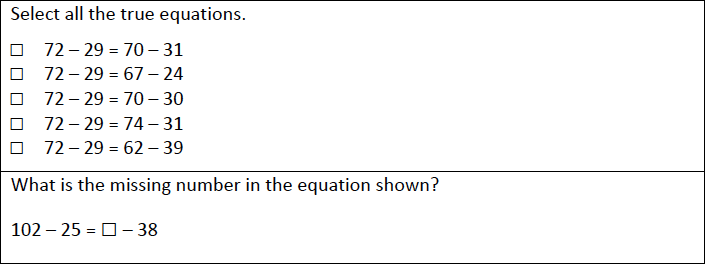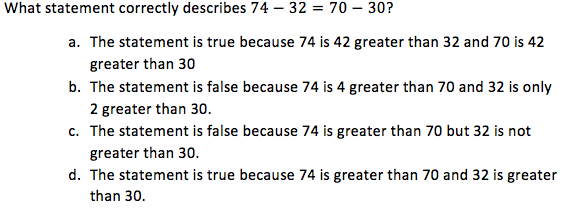Determine whether an equation is true or false by using comparative relational thinking. For example, without adding 60 and 24, determine whether the equation 60 + 24 = 57 + 27 is true or false.
[divider] [/divider]Students are able to…
- Determine whether an equation is true or false where operations are used on both sides of the equal sign and justify by using comparative relational thinking.
- Recognize the meaning of mathematical vocabulary, including: variable, product, quotient, sum, difference, and equation.
[divider] [/divider]Students are able to…because teachers…
- Deliver apple opportunities for students to answer and discuss number relationships in comparative rational thinking questions.
- Provide opportunities for students to strengthen comparative rational thinking vocabulary.
[divider] [/divider]Questions to ask students:
- Without adding 40 and 12, determine whether the equation 40 + 12 = 37 + 15 is true or false.
- Sample answer that indicates understanding: The student identifies that 40 is 3 more than 37 and 12 is 3 less than 15 so, the equation is correct.
- Sample answer that indicates an incomplete understanding or a misconception: The student cannot rationally compare the values of both sides and must add them to determine whether the statement is true or false.
[divider] [/divider]FSA Notes
Cognitive Complexity Level: n/a
Achievement Level Descriptors:
2- determines whether an equation is true or false; identifies true and false equations that use comparative relational thinking
3- determines whether an equation is true or false, where addition or subtraction is used on both sides of the equal sign, and justifies by using comparative relational thinking
4- determines whether an equation is true or false, where multiplication or division is used on both sides of the equal sign, and justifies by using comparative relational thinking
5- determines whether an equation is true or false, where different operations are used on either side of the equal sign, and justifies by using comparative relational thinking
Assessment Limits:
Whole number equations are limited to:
- addition and subtraction within 1,000.
- multiplication of 2‐digit by 1‐digit or a multiple of 10 by a 1‐digit.
- division of 2‐digit by 1‐digit.
Variables represented by a letter are allowable.
[divider] [/divider]Additional Resources:
Lesson: Find the missing number in an equation
Lesson: Is the equation True or False
[divider] [/divider]Sample Formative Assessment Tasks:

